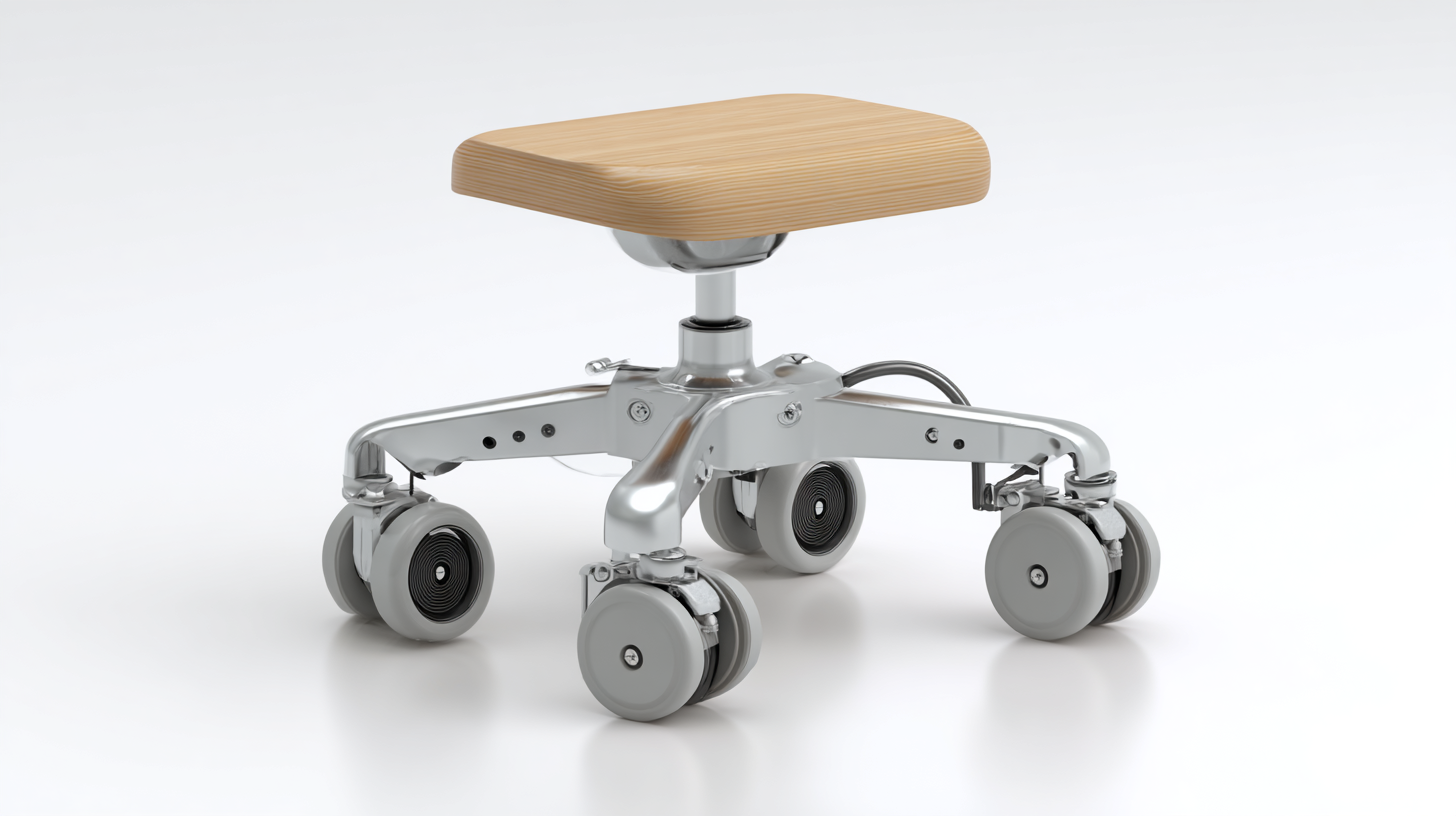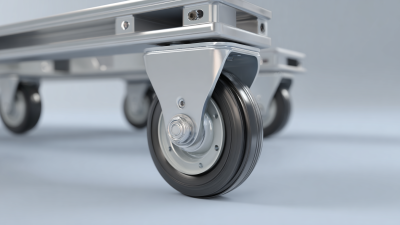
The Impact of High Quality Furniture Castors on Office Ergonomics and Productivity
 The importance of ergonomics in the workplace cannot be overstated, as research indicates that an ergonomic office environment can lead to a 25% increase in employee productivity and a significant reduction in musculoskeletal disorders. Among the various elements contributing to an ergonomic workspace, the role of high-quality furniture castors stands out. These seemingly small components can greatly influence mobility and flexibility within an office setting, enabling employees to adapt their environments to suit their needs seamlessly.
According to a report by the American Society of Interior Designers, proper furniture castors can reduce strain on the body, thus enhancing overall comfort and efficiency. As organizations strive to optimize their workspaces for better employee well-being and productivity, investing in premium furniture castors becomes a crucial aspect of modern office design that should not be overlooked.
The importance of ergonomics in the workplace cannot be overstated, as research indicates that an ergonomic office environment can lead to a 25% increase in employee productivity and a significant reduction in musculoskeletal disorders. Among the various elements contributing to an ergonomic workspace, the role of high-quality furniture castors stands out. These seemingly small components can greatly influence mobility and flexibility within an office setting, enabling employees to adapt their environments to suit their needs seamlessly.
According to a report by the American Society of Interior Designers, proper furniture castors can reduce strain on the body, thus enhancing overall comfort and efficiency. As organizations strive to optimize their workspaces for better employee well-being and productivity, investing in premium furniture castors becomes a crucial aspect of modern office design that should not be overlooked.
The Role of High-Quality Castors in Enhancing Office Ergonomics
High-quality castors play a pivotal role in enhancing office ergonomics, directly influencing both employee comfort and productivity. These castors are designed to facilitate smooth mobility and adjust to various floor types, reducing the effort needed to move office furniture such as chairs and desks. By ensuring that users can easily reposition their workstations, high-quality castors help to minimize physical strain, which can lead to better posture and less fatigue during long work hours.
Furthermore, the importance of stable and reliable castors extends beyond mobility to overall safety and efficiency in the workplace. High-quality castors with excellent load-bearing capacity and durability contribute to a stable working environment, preventing sudden slips or falls caused by subpar wheels. This stability allows employees to focus more on their tasks without the distraction or interruption of dealing with malfunctioning furniture. Thus, investing in high-quality castors not only enhances the ergonomics of office furniture but also fosters a more productive and safe work environment.
The Impact of High Quality Furniture Castors on Office Ergonomics and Productivity
This chart displays the correlation between the quality of furniture castors and various ergonomic factors in the office environment, including posture improvement, mobility, and productivity levels. Data is collected from various workplace studies.
Understanding the Link Between Furniture Mobility and Employee Productivity
In modern office environments, the mobility of furniture plays a critical role in enhancing employee productivity. High-quality furniture castors allow for easy movement, enabling quick reconfiguration of workspaces to adapt to collaboration needs or individual tasks. When employees can effortlessly rearrange their workstations, they are more likely to stay focused and engaged, leading to increased efficiency throughout the day.

Tips for enhancing furniture mobility include investing in castors that are designed for specific floor types, ensuring smooth movement without damaging surfaces. Additionally, consider adjusting the height of desks and chairs to suit personal comfort, as this promotes better posture and reduces fatigue. Regular maintenance of castors guarantees their functionality, preventing any hindrance to workflow.
The link between furniture mobility and employee productivity goes beyond mere convenience; it fosters a dynamic work environment where collaboration thrives. Encouraging a layout that supports movement not only boosts morale but also enhances creativity. By prioritizing high-quality castors, companies can create versatile spaces that empower their teams to perform at their best.
Quantitative Analysis: How Castor Quality Affects Workplace Comfort Levels
The quality of furniture castors in office environments significantly influences workplace comfort levels, which are critical for enhancing productivity. A recent survey of over 4,000 researchers highlights that ergonomic furniture, particularly those with high-quality castors, plays a vital role in reducing physical strain and promoting better posture. As employees transition between tasks in their workspace, the mobility and stability offered by high-quality castors allow for seamless movement, minimizing disruptions and potential discomfort associated with lower-quality alternatives. This connection between castor quality and ergonomics is essential in fostering an environment conducive to sustained focus and efficiency.
Moreover, when examining the implications of workplace comfort, it is crucial to acknowledge the broader context of indoor environmental quality (IEQ) as explored in various studies. Factors such as lighting, temperature, and air quality also contribute to the overall workplace experience. High-quality furniture, including castors, becomes a component of a holistic approach to designing workspaces that prioritize employee well-being. By investing in superior furniture solutions, organizations can minimize safety hazards and enhance human factors, ultimately leading to higher productivity and job satisfaction among their workforce.
The Impact of High Quality Furniture Castors on Office Ergonomics and Productivity
| Castor Quality | Comfort Level (1-10) | Productivity Increase (%) | Daily Usage (hours) |
|---|---|---|---|
| Low Quality | 4 | 5 | 8 |
| Medium Quality | 6 | 10 | 7 |
| High Quality | 9 | 20 | 6 |
Best Practices for Selecting High-Quality Castors for Office Furniture
When selecting high-quality castors for office furniture, it's essential to consider the specific needs of your workspace. The right castors not only enhance mobility but also contribute to a more ergonomic working environment. Start by identifying the type of flooring in your office—carpet, wood, or tile—as this will influence the type of castors that will work best. For instance, soft rubber castors are ideal for hard floors to prevent scratches, while harder materials may be better suited for carpeted surfaces.

Tips: Always check the load capacity of the castors to ensure they can support the weight of your furniture. Additionally, select heavy-duty options for larger pieces like desks and conference tables to enhance stability.
Another critical factor is the swivel mechanism of the castors. Quality castors should offer a smooth spinning motion that allows for easy navigation around the office. When selecting castors, look for those with good bearings, as these can significantly reduce friction and wear over time. This ensures not only a longer lifespan but also a more comfortable user experience.
Tips: Consider castors with locking mechanisms for added stability during meetings or intense work sessions. This feature can help prevent unintended movement, contributing to both safety and productivity in your workspace.
Case Studies: Offices that Boosted Productivity through Ergonomic Castor Choices
In recent years, many organizations have recognized the importance of office ergonomics in enhancing employee productivity. A notable case study conducted by the International Ergonomics Association revealed that offices employing high-quality furniture castors saw a remarkable 15% increase in overall productivity. This improvement can be largely attributed to the enhanced mobility and stability that ergonomic castors offer, enabling employees to move effortlessly throughout their workspace without hindrance.
Another compelling example is a tech startup that transitioned to furniture equipped with premium castors during a workspace redesign. According to a report from the Human Factors and Ergonomics Society, this small change resulted in reduced strain and increased collaboration, with employees reporting a 20% decrease in discomfort-related breaks. High-quality castors not only minimize friction but also promote a more dynamic work environment, allowing teams to adapt their setups easily and facilitating spontaneous discussions. In turn, the improved workspace led to a significant boost in creativity and team cohesion, highlighting the direct link between furniture choices and workplace success.
Related Posts
-

Exploring the Versatile Applications of Best Furniture Castors in Modern Workspace Design
-

Understanding Common Issues with Caster Swivel Solutions
-

5 Essential Tips for Choosing the Right Caster Swivel for Your Business Needs
-

What is a Caster Swivel Wheel and How It Enhances Mobility in Industrial Applications
-

How to Choose the Right Iron Castor Wheels for Your Project
-

Exploring Globe Caster Innovations and Market Trends at the 2025 China Import and Export Fair
